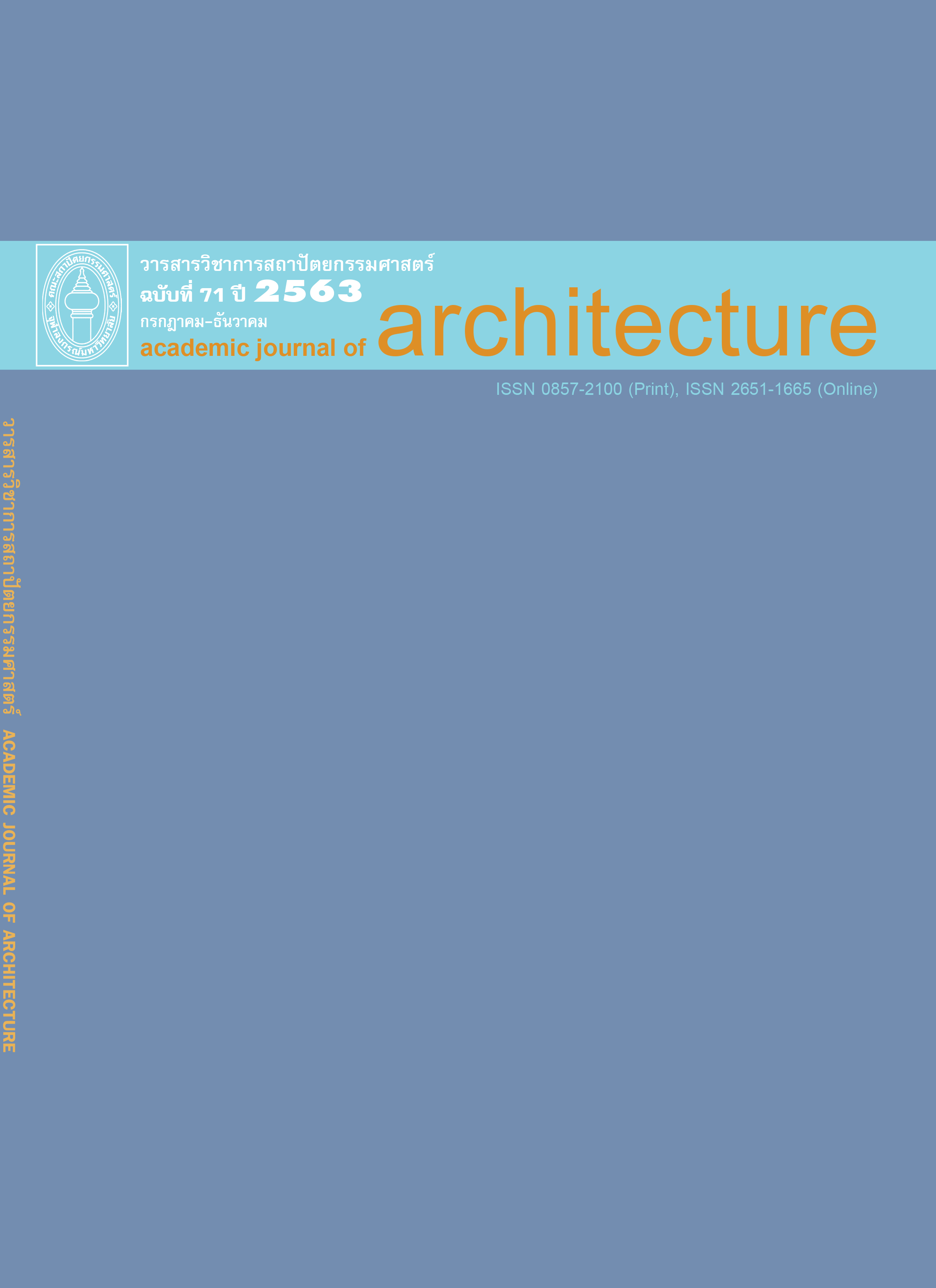Spatial Sustainability of Eco-Friendly Urban Park : A Case Study of Lampang Municipality
Main Article Content
Abstract
Developing the urban environment by promoting green areas and parks is a standpoint of the urban development strategy of Lampang City Municipality to improve the environment to be a sustainable living city. This research study aimed to analyze the spatial sustainability of urban parks in Lampang City Municipality based on the relationship between the parks’ spatial services such as the use of city buildings and structures, the locations and servicing areas of the parks, thoroughfare networks, and the potential to access the park areas at the city level, and the use of public park areas such as the components of the parks, accessibility to the services and activities in the parks. The methods of study were documentary analysis, surveying, interviews, Geo-Informatics Systems, and Space syntax models. It was found that Lampang City Municipality had 5 neighborhood parks and 3 community and district parks. The environmentally friendly spatial sustainability was caused by the relationship of spatial services of the parks, and the use of public park areas, namely the parks with high access potential between 0.975690 – 0.8824835. Their characteristics were consistent with those of the use contexts of commercial and residential buildings. The components within the parks met the standard criteria. There was a huge variety of users and activities. The park groups with medium and low access potential values between 0.8496436 - 0.5730965 had locations in residential areas. The components within the parks met the standard criteria. There was a wide range of users and fewer activities. On average, 33.04 percent of city park users used eco-friendly traffic on foot and bicycle to access to the parks. Besides, the locations and servicing areas of Lampang City Municipal parks could facilitate the development opportunities to link thoroughfare networks, public spaces, and the areas along
the Wang River for the development of a green network covering urban areas for future utilization.
Article Details
References
กรมโยธาธิการและผังเมือง. (2551). โครงการศึกษาตัวแบบมาตรฐานที่ใช้ในการวิเคราะห์เพื่อการวางผังเมืองรวม. กรุงเทพฯ: บริษัท พิฆเณศ พริ้นติ้ง เซ็นเตอร์ จำกัด.
ไขศรี ภักดิ์สุขเจริญ. (2562). พื้นที่เมืองและความเป็นสาธารณะ Urban space and publicness. กรุงเทพฯ: บริษัท ลายเส้น พับบลิชชิ่ง จำกัด.
ดวงจันทร์ อาภาวัชรุตม์ เจริญเมือง. (2542). เมืองในสังคมไทย กำเนิด พัฒนาการ และแนวโน้ม. เชียงใหม่: สถาบันวิจัยสังคม มหาวิทยาลัยเชียงใหม่.
เทศบาลนครลำปาง. (2561). ข้อมูลพื้นฐานเทศบาลนครลำปาง. สืบค้นเมื่อ 15 พฤษภาคม 2563, จาก http://w w w . l a m p a n g c i t y . g o . t h / m a i n s /information?category=9
ศูนย์ออกแบบและพัฒนาเมือง. (2562). Let’s walk พาบางกอกออกเดิน. กรุงเทพฯ: ศูนย์ออกแบบและพัฒนาเมือง จุฬาลงกรณ์มหาวิทยาลัย.
ระวิวรรณ โอฬารรัตน์มณี. (2557). แนวคิดพื้นที่สาธารณะในมุมมองตะวันตกและตะวันออก. ใน สันต์ สุวัจฉราภินันท์, บรรณาธิการ, ว่าด้วยทฤษฎีทางสถาปัตยกรรม: พื้นที่สาธารณะและพื้นที่ทางสังคม. (น.30-53). เชียงใหม่: สำนักพิมพ์มหาวิทยาลัยเชียงใหม่.
อภิรดี เกษมศุข. (2561). สเปซซินแท็กซ์ หนึ่งการศึกษาสัณฐานวิทยาเมือง. กรุงเทพฯ: เมจิค พับบลิเคชั่น.
Al_Sayed, Kinda. (2018). Space syntax methodology. London: UCL Publication.
Gehl, Jan. (2011). Life between building using public space. Washington: Island Press.
Hillier, Bill. (1999). Centrality as a process: Accounting for attraction in equalities in deform grid. Urban Design International. Retrieved 2020, May 14, from https://www.tandfonline.com/doi/abs/10.1080/135753199350036
Project for Public Space. (2012). How PPS drive change. Retrieved 2020, May 14, from https://www.pps.org/article/how-pps-drives-change
Whittick, Arnold. (1974). Encyclopaedia of urban planning. New York: McGraw-Hill Book.


